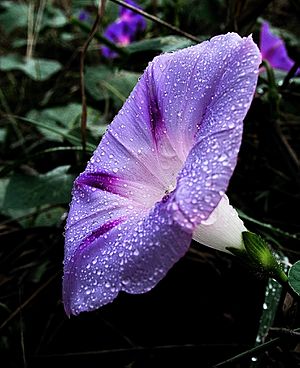Common morning-glory facts for kids
Quick facts for kids Common morning-glory |
|
|---|---|
 |
|
| Scientific classification | |
| Genus: |
Ipomoea
|
| Species: |
purpurea
|
The common morning-glory (also called tall morning-glory or purple morning glory) is a beautiful flowering plant. Its scientific name is Ipomoea purpurea. This plant originally comes from Mexico and Central America.
About the Plant
Like other morning glories, this plant loves to climb. It wraps itself around fences, poles, or other plants. It can grow quite tall, reaching about 2 to 3 meters (6 to 10 feet) high.
The leaves of the common morning-glory are shaped like hearts. Its stems are covered with soft, brown hairs. The flowers look like trumpets. They are usually blue, purple, or white. Each flower is about 3 to 6 centimeters (1 to 2.5 inches) wide.
Where It Grows
This plant prefers soil that is moist and rich in nutrients. However, it can grow in many different types of soil. You can find it growing naturally in warm parts of the world. It has spread to many places beyond its original home.
Sometimes, people consider the common morning-glory a weed because it grows so easily. But many people also grow it on purpose. They love its pretty purple and white flowers. There are many different types, or cultivars, of this plant. Some popular ones include:
- I. purpurea 'Crimson Rambler' (which has red-violet flowers with white centers)
- 'Grandpa Ott's'
- 'Kniola's Black Knight'
- 'Star of Yelta' (with deep purple flowers)
- 'Milky Way' (which has white flowers with light purple touches)
Flower Colors
The amazing colors of the morning-glory flowers come from special natural chemicals. These chemicals are called anthocyanins.
- Violet-blue flowers get their color from a type of anthocyanin called cyanidin.
- Red-purple flowers get their color from a different type of anthocyanin called pelargonidin.
These chemicals help give the flowers their beautiful shades.
Gallery
-
I. purpurea in Loganville, Georgia
See also
 In Spanish: Gloria de la mañana para niños
In Spanish: Gloria de la mañana para niños










